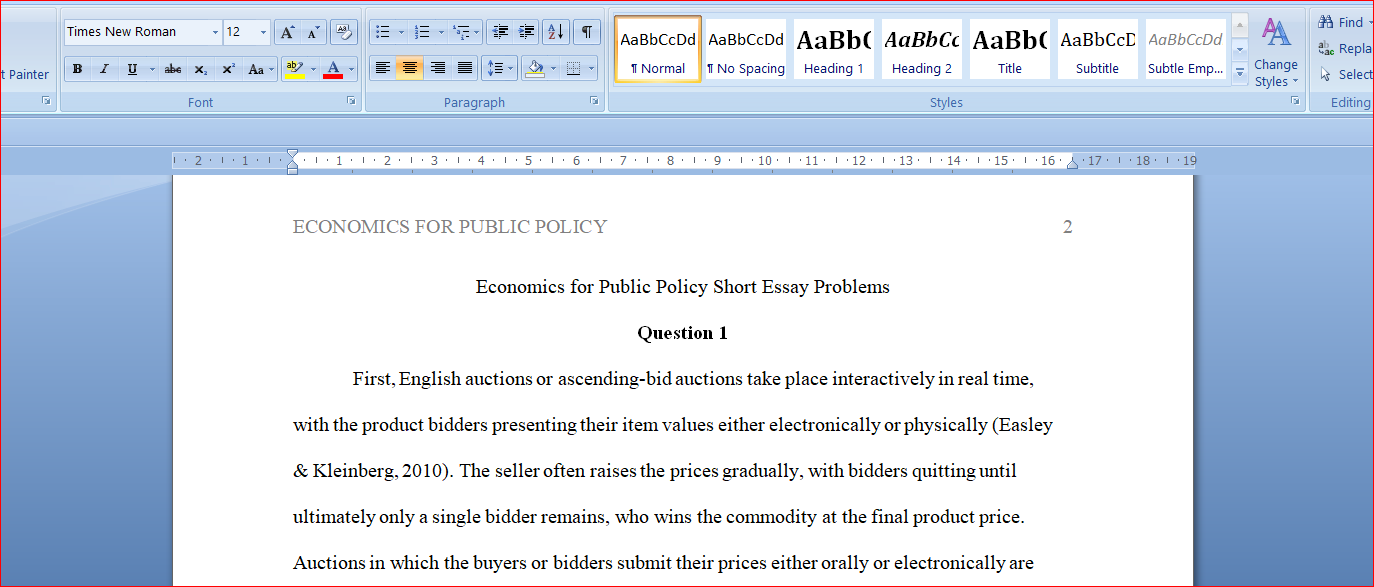Discuss economics for public policy short essay problems
Problem Set Two
1. Suppose that you have 100 identical units of a product that you would like to sell for the highest possible total revenue. Also suppose that you will be using the English auction to dispose of these objects. There are a variety of different ways that the objects might be bundled and sold. You could auction off all 100 units in a single auction. At the other end
of the spectrum, you could auction each unit separately through a series of 100 separate auctions. You could bundle the units in groups of 10 units and conduct 10 auctions. Or you could have 5 auctions of 20 units each. And so forth. What information about the buyers would you need to know to determine how an optimal, revenue maximizing disposal of the 100 units should be conducted?
(Note: Go to supply and demand. The buyer has a demand for all 100 units in a single auction setting; perhaps including zero-values
at the end of his schedule. How much would he bid? The mean/median: I would think. If all do price is determined by second-
priced mean/median buyers” bid. Other end of the spectrum: one unit at a time.
Bid aggressively for you first most-valued unit. Or wait. What do you know about the other buyers”? It becomes Dutch; with all of
its aspects.
With the middle trances a blend of the two end-points.)
2. Most retail shopping in the United States operates under the rules of a posted-offer pricing system. During each sales period in this form of market institution, sellers set take-it-or-leave-it prices, buyer shop the stores or electronic outlets for products, and buyers decide whether and how much to buy. Then, in the next trading period, sellers may decide to change the amounts and prices of the product they are selling and the market process begins anew. Explain how, when there are large numbers of buyers and sellers, the “invisible hand” will work in this situation so as to produce a competitive
market outcome.
(Note: Open-ended question but I wanted to see how you would handle (model) and see the one-sided process of conversion by the sellers. )
3. It is a well-established fact that, after the incidence of a natural disaster, prices for basic commodities in stricken regions tend to spike upwards. Earthquakes, tornados, hurricanes, ice storms, and other types of temporal disasters all tend to generate such effects. A noted example is the phenomena of standard bags of ice tending to move immediately to $5.00 per bag after a disaster. Consider supply and demand for ice after a disaster. How are they affected in the short and in the long run? Often, there is expressed outrage about sellers moving ice at $5.00 per bag that is often accompanied with calls for
government to impose price-caps or heavy taxes on bags of ice. Consider the equity/efficiency trade-offs associated with imposing such forms of policies on ice after disastrous events.
(Note: Again, supply and demand. Analyze the simultaneous fall/rise of later/former and discuss the availability of no bags of ice versus compared to highly priced ice. )
4. Illinois currently taxes tobacco products and simultaneously promotes anti-tobacco information campaigns. Efforts are currently underway to legalize marijuana in the state. If marijuana were to become legalized in the state, how might it best to taxed in a way that also reduces tobacco usage? What affect might the legalization of marijuana have on the (also taxed) market for alcohol products?
Answer preview for discuss economics for public policy short essay problems
Words:1808

